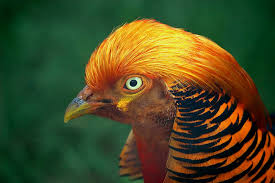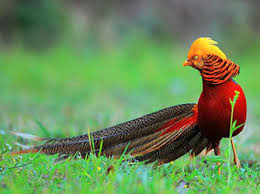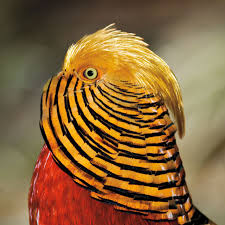The Golden Pheasant, also known as the "Chinese Pheasant" is one of the more popular species of pheasant
which is native to the mountainous forests of Western and Central China.
The Golden Pheasant was introduced to the United Kingdom around 100 years ago and there are around 101 - 118
mating pairs in the summer. This hardy, gamebird belongs to the order: Galliformes and is a smaller species
of pheasant.
The Golden Pheasant along with Lady Amherst Pheasant (Chrysolophus amherstiae), make up the group of "Ruffed
Pheasants" named for their ruff which is spread across their face and neck during courtship.
Description
Male and female Golden Pheasants look different in appearance. Males measure 90 - 105 centimetres in length
with the tail making up two thirds of the total length. Females are slightly smaller measuring 60 - 80
centimetres in length with the tail making up half of the total length. Their wingspan is around 70
centimetres and they weigh around 630 grams.
Male Golden Pheasants can be easily identified by their bright colouring. They have a golden crest tipped
with red which extends from the top of their heads, down their necks. They have bright red underparts, dark
coloured wings and a pale brown, long, barred tail. Their rumps are also golden, upper backs are green and
they have bright yellow eyes with a small black pupil. Their face, throat and chin are a rust colour and
their wattles and orbital skin are yellow. Beak, legs and feet are also yellow.
Female Golden Pheasants are less colourful and more duller than males. They have a mottled brown plumage,
pale brown face, throat, breast and sides, pale yellow feet and are more slender in appearance.
Habitat
The Golden Pheasant’s preferred habitats are dense forests and woodlands and sparse undergrowth.
Diet
Golden Pheasants mainly feed on the ground on grain, invertebrates, berries, grubs and seeds as well as
other kinds of vegetation.
Behavior
Golden Pheasants are very timid birds and will hide in dark, dense forests and woodlands during the day and
roost in very high trees during the night. Golden Pheasants often forage on the ground despite their ability
to fly, this may be because they are quite clumsy in flight. However, if they are startled, they are capable
of taking off in a sudden fast upward motion with a distinctive wing sound.
Little is known about their behaviour in the wild as although the males are very colourful birds, they are
difficult to spot. The best time to possibly observe a Golden Pheasant is very early in the morning when
they may be seen in clearings.
Vocalisations include a "chack chack" sound. Males have a distinctive metallic call during the breeding
season. Also, during the males elaborate courtship display, he will spread his neck feathers over his head
and beak, like a cape.
Reproduction
Female Golden Pheasants lay around 8 - 12 eggs in April. Incubation time is around 22 - 23 days. The chicks
fledge after 12 - 14 days. Males acquire their bright colours during their second year of life but are
sexually mature in their first year. The life span of a Golden Pheasant is 5 - 6 years.









